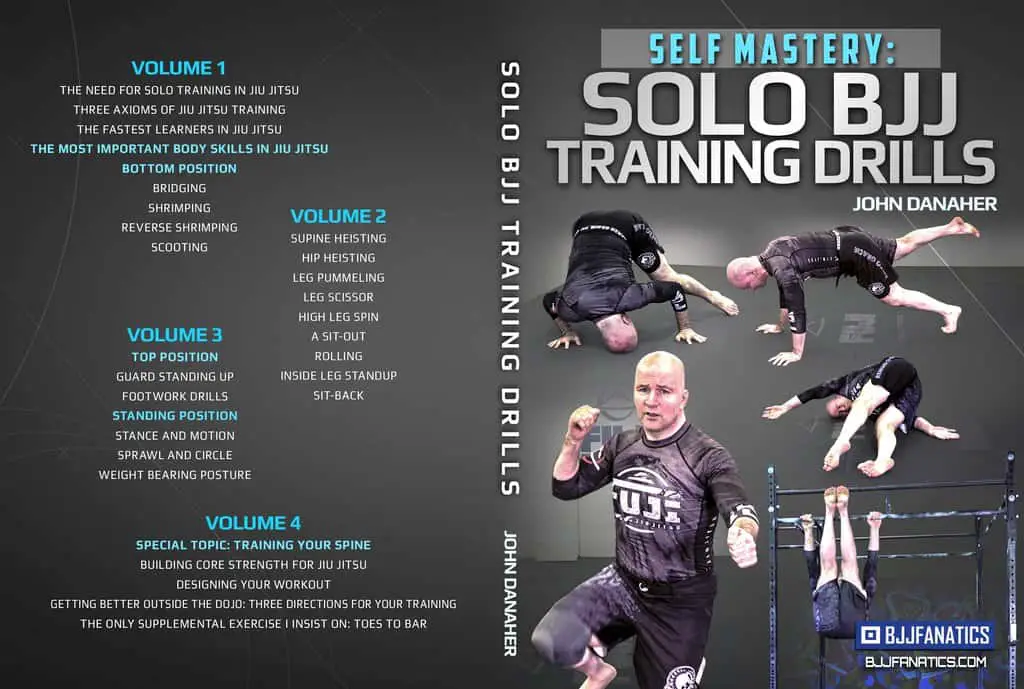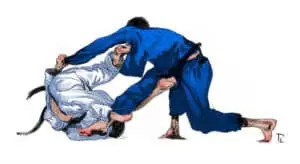
BJJ athletes are always looking for ways to improve their game, tap out that gym rival who always seems to get the best of them or earn that next belt. Many of us wish we could attend BJJ classes 6 days a week but that is not always possible. So it’s natural to wonder whether or not training off the mats can improve your BJJ ability
While there is no substitute for training BJJ at your gym, there are specific things you can do by yourself outside of your academy to elevate your BJJ skills. It is time to show you what solo training is effective for BJJ.
How to improve BJJ off the mats?
To improve your BJJ off the mats you can increase your strength and cardio by performing a strength and conditioning workout 2 to 3 times a week. You increase your flexibility through daily static stretching. You can increase your technical knowledge through watching BJJ instructionals.
Improve Your Strength For BJJ Through Solo Training

BJJ athletes need to be explosive, able to display high amounts of maximal strength and have high significant muscular endurance to enable them to last an entire match.
These athletic qualities are best developed through a well designed strength and conditioning program. Weightlifting, plyometrics and jump training are some of the most effective methods to develop the strength you need on the BJJ mats.
The great news is that strength and power can easily be trained by yourself in a gym. You do not need to be at your BJJ academy to turn yourself into a powerful Hulk.
If you are looking to increase your strength and power for BJJ then follow this customised version of the famous 5/3/1 program. It is simple to follow and will deliver big time gains in a short period of time.
| Week 1 | Week 2 | Week 3 | Week 4 | |
| Set 1 | x5 Reps @ 65% 1RM | x3 reps @ 70% 1RM | x5 reps @ 75% 1RM | x5 reps @ 40% 1RM |
| Set 2 | x5 reps @ 75% 1RM | x3 reps @ 80% 1RM | x3 reps @ 85% 1RM | x5 reps @ 50% 1RM |
| Set 3 | x5+ reps @ 85% 1RM | x3+ reps @ 90% 1RM | x1+ reps @ 95% 1RM | x5 reps @ 60% 1RM |
Session 1 (Monday/Tuesday)
A1: Tuck Jumps, 6X4
A2: Bounding Broad Jumps, 6X4
B: Power Clean, training loads, reps and sets based on 5/3/1 Protocol
C1: Back Squat, training loads, reps and sets based on 5/3/1 Protocol
C2: Bent Over Rows, 3X8
Session 2 (Thursday)
A: Barbell Jumps, 6X4
B1: Push Press, training loads, reps and sets based on 5/3/1 Protocol
B2: Pull Ups, 4 sets, Max Reps
C1: Clean or Snatch pull, training loads, reps and sets based on 5/3/1 Protocol
C2: Kettlebell Preacher Curls, 3X12
The goal of 5/3/1 is to build overall strength in a BJJ athlete. 5/3/1 consists of a 4 week mini training cycle, consisting of 3 weeks of linear progression and then a deload in the 4th week. After the deload you recommence the program, with slightly higher starting weights. athletes restart the program with slightly higher training loads.
Increase Your BJJ Flexibility Through At Home Stretching Routines

BJJ athletes need to be very flexible. Many of the techniques in BJJ require high levels of mobility and to move at your best on the mats you need to be supple and comfortable contorting your body at odd angles.
Luckily, mobility and flexibility can be developed by BJJ athletes through simple at home stretching routines. If BJJ athletes constantly stretch while off the mats they will notice a big improvement in their overall flexibility when they attend class.
BJJ athletes should undertake dynamic and ballistic stretching in the morning and before workouts to improve range of motion without affecting strength levels. Following BJJ training athletes should perform static stretching as this is most effective at cementing permanent flexibility improvements.
Ballistic stretching doesn’t have the best reputation because it uses momentum to push a body part through full range of motion. However, if BJJ athletes are conservative and don’t force their body parts past their normal range of motion and keep the movement controlled it is an effective way to improve mobility.
Here is an example of a ballistic stretch for a BJJ athlete:
Lie on stomach
Grab foot and pull towards butt until heel touches.
Hold for 30 seconds
Switch legs
Make sure when you are doing ballistic stretching that you use slow and controlled bounces and swings.
Dynamic stretching involves stretching your muscles and joints through a whole range of motion using circular motions and sport specific movements. Dynamic stretching helps BJJ athletes remove any pre training stiffness or discomfort.
Dynamic stretching should be performed as part of your warm up or even beforehand.
Dynamic Stretches For BJJ Athletes:
1. High Knees – raise knees to chest
2. Kick Backs – bring your heel to your butt
3. Knee Circles – bring knee out to the side, parallel with the floor, and then into the middle of your body and down.
4. Skipping – skip high into the air, roll your shoulder up and over to get more height
5. Carioca – move horizontally while lifting and bringing your inside leg over your outside leg, you should be twisting your back as you perform these
6. Bear walk – get on all fours and move forward, knees and stomach do not touch the ground
7. Run Hand Across Ground – as you are jogging bend down and run hand across the ground, keep a straight back and squat
8. Hopping – bounce around on one leg, can you hop the spot or move in different directions
9. Chest Hug – jump and hug your knees as you are in the air
10. Straight Leg Run – run forwards but keep your legs extended, use arms to propel you forward
After you have completed your BJJ training then it is time to undertake static stretching. Static stretching is all about making permanent gains in flexibility. Studies have shown that static stretching is the best method to permanently alter your joint and muscle range of motion.
An interesting study compared static stretching, self stretching and PNF stretching to a control group. The static stretching group was the only group to significantly improve their flexibility compared to the control group.
BJJ athletes need to perform static stretches that focus on the lower limbs (knees, groin, ankles, hip and hamstrings) as these are at risk of injury and play a big role in Jiu Jitsu. BJJ players should also focus on stretching the neck as it is placed under a lot of stress during grappling.
BJJ players should not perform static stretches prior to BJJ training as studies have shown that static stretching decreases power output when performed before sports training.
Elevate Your BJJ Technical Knowledge By Watching Instructionals By Yourself

While learning in person from your coach at your local BJJ gym is by far the most effective way to soak up BJJ knowledge it is not the only way. With the explosion of BJJ and the internet, athletes can now easily access thousands and thousands of hours of training material online.
BJJ players can achieve huge leaps in their skills by implementing new techniques learned through watching Jiu Jitsu instructionals.
BJJ athletes need to be careful that they are learning from respectable sources and that when they go to put their newly learned moves into practice they are doing them correctly.
If you are looking for high quality online BJJ instructionals then check out Keenan Cornelius, Marcelo Garcia or BJJFanatics, they both have lots of free content on YouTube and once you become more advanced you can then consider paying for their premium content.
